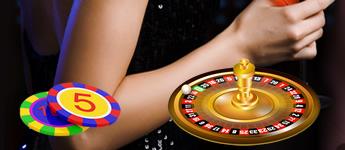|
Blackjack is
one of the most widely played casino games
in the world. Also known as twenty-one, it
is a card game that compares the hand
values of the dealer and one or more
players. While it is not known where the
game originated, there do exist references
to similar games as far back as the
seventeenth century. The goal of the game
is to reach as close to a point value of
21 as possible, without going over.
Players that go over, or bust,
automatically lose. Winners are determined
by comparing each player hand to the
dealer's hand, with each player hand able
to win or lose against the dealer
independent of the others. Hand values are
determined by adding up the point values
of each card in the hand. Face cards count
as ten points, while number cards use
their number value. Aces count as either 1
or 11, whichever is more beneficial to the
hand. A hand that consists of an ace and a
card with a point value of 10 is called a
blackjack, and beats any other hand except
another blackjack.
Blackjack is played with at least one
standard deck of 52 cards, though in
casinos up to eight decks may be shuffled
together. A dealer starts by dealing a
card, face up, to each player, starting
with the player to the dealer's right,
including the dealer. A second face up
card is dealt to each player to complete
their initial hands, and the dealer
receives a second card face down as well.
Starting from the player to the dealer's
right, each player then takes a turn,
where they can choose a number of actions.
Players may either hit, stand, surrender
or double down. If a player's first two
cards are the same, players may also
choose to split.
When all players are done, the dealer then
may hit or stand, depending on the rules
set by the casino. If the dealer busts,
all players who did not previously bust
automatically win. Each player's hand is
then compared to the dealer's hand, with
the higher value winning the round. In the
case of a tie, the round is considered a
“push” and the player's wager is typically
returned. On each player's turn, they may
choose to hit, stand, double down or
surrender, or if the conditions are met,
they may split. Players may audibly
declare their choice, or use hand signals
that are generally accepted in most
casinos. Hand signals take priority over
verbal instructions, and disputes with
dealer actions will consider hand signals
over other forms. If a player hits,
another card is dealt to that player,
increasing the value of the hand by the
point value of the added card.
If the total is not 21 or the player does
not bust, the player may choose to hit
again or stand. Players may either scrape
their cards on the table if holding their
hand, or if the hand is on the table, may
wave hand towards themselves or tap the
table to declare a hit. A player who
stands or stays chooses to keep their
current hand and accept no more cards. The
next player then takes their turn. If
holding the hand, players may slide cards
under their chips to denote a stand, or if
cards are face up on the table, may wave
their hand horizontally. A double down is
only available as a choice for the
player's first action. This increases the
bet by one hundred percent, and the player
is dealt one more card. The player is then
forced to stand on their current hand. The
action for this is to place additional
chips to match the current bet beside the
original bet, then to point with one
finger.
A player may choose to split if the first
two cards in the hand have the same value.
This splits the two cards into two
separate hands, and the player must place
additional chips equal to the original
wager so that each hand has the same bet
amount. The dealer then deals one
additional card to each new hand, and the
player plays each hand separately from the
other. In the case of a split, however,
blackjacks are usually treated as
non-blackjack 21's. Players may signal
this choice by placing additional chips
beside the original bet, and pointing with
two fingers in a V. A surrender is
available only as the first choice in a
hand, and is not a valid choice in all
casinos. The house takes half the player's
bet and returns the rest, and the hand is
no longer played. There is no recognized
hand signal to surrender.
Players place their bets before the cards
are dealt, a sign that they desire to play
this round. While the size of the table
limits the number of players, casinos
typically allow others watching the game
to also place their bets on any player's
hand. A winning hand receives a payout
equivalent to the size of the bet, though
in some casinos blackjacks are paid
higher. As with most other games, casino
tables have a minimum and maximum bet, and
as mentioned previously, may allow players
to surrender instead of continue play with
their hand. Many casinos also allow side
bets, which are placed in designated
areas. Insurance is a commonly accepted
side bet offered by most casinos as well.
The option is made available to players
when the dealer's face up card is an ace,
and is a wager that the dealer has a
blackjack. It pays 2:1, and the player is
typically allowed to wager up to half the
value of their original bet.
|


